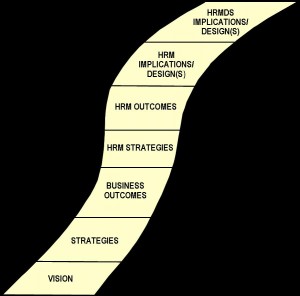In my 2/9/2010 post, I announced that I would be publishing my strategic HRM delivery systems planning methodology on this blog, so I thought I’d better get started. Although there’s a very geeky set of materials to guide me on these projects, I call the version of my methodology intended for clients, “follow the yellow brick road.” It’s the path (at least in my childhood memories of the Oz books) to finding the answers to important HRM and HRM delivery systems strategy and design questions for an individual end-user organization or for an HRM software/services vendor on behalf of their defined target market and intended scope of products/services.
Before we fling ourselves into the methodology itself, I want to set the stage. During my career, there have been enormous changes in the environment, the context, in which our organizations must operate and, therefore, in the challenges that our organizations must meet and overcome. That organizational context has gotten much more complex and is changing much faster than CEOs of my early days experienced; these are tougher times in which to lead. Meeting today’s challenges requires entirely new organizational strategies and business approaches that would have been unheard of or even ridiculous to contemplate at the start of my career. And I can tell you that every year’s update of the methodology and its “starter kits,” is much more than mere tweaking because of these changes. So, before we look inward at our own organizations, or at the organizations with which we as product vendors or service providers want to do business, I thought we’d better set the stage a la 2010.
The Changing Organizational Context
Today’s organizations are subject to many or all of the following environmental pressures as well as to the combinatorial effects of these pressures:
- Fierce, often global competition — for customers, competencies, capital, technology, suppliers, ideas, intellectual property, market and mind share, and influence;
- Growing customer information access and decision-making sophistication — about their business needs, their product and service choices, and the financial implications of both;
- Rapid changes in information technology — with improved availability, ease of use, and affordability, but also greater complexity of choices, integration and management;
- Nearly pervasive information and information technology — from embedded systems to manufacturing robotics, universal e-mail/IM/cellular, Web 2.0 and Web ubiquity, and every teenager’s mastery of the basics;
- Changing business models and investment strategies as work is digitized and moves to where it can be done with the best combination of cost, quality, speed and risk;
- Tremendous growth and availability of knowledge — and with much shorter cycle times for its creation and obsolescence;
- Pent-up demand for scarce competencies — and those workers in greatest demand vote with their feet — even as there are a glut of less in demand workers;
- Increasing regulatory coverage and enforcement — of environmental, trade, labor, security and financial activities — and in the sheer number of regulatory bodies having jurisdiction over our business activities; and
- Enormous pressure to do the right things faster and better and with fewer, less expensive resources.
The Range Of Organizational Strategies
Within this context, to be successful, growth-oriented and cohesive organizations must undertake many of these strategies concurrently, dealing with the resulting complexity of their interplay:
- Comply with but are not driven to poor business decisions by regulations or labor contracts;
- Achieve significant economies of scale, in-house and through ITO and BPO partnerships, without bureaucracy, and without loss of flexibility, speed, or security/privacy;
- Maximize the business value of their own assets, including their workforce, while partnering to enhance time-to-market, enter new markets, tap into expert providers for essential but non-core capabilities and, in general, extend their reach;
- Attract and retain the best possible workforce — be the “employer of choice” — and enhance the productivity, the real effectiveness, of their workers, especially those with critical, but often scarce, competencies and those in key positions;
- Increase the speed with which and range over which they are able to change while avoiding change for its own sake;
- Make the capabilities of their workforce, enabled via information, information technology and effective HRM, their primary source of sustained leverage and competitive advantage;
- Rethink their business models to leverage such key IT-enabled capabilities as mass customization, disintermediation, experience-based interaction, borderless commerce, and write once/read everywhere — and then apply this same thinking to other potentially disruptive technologies, e.g. Web 2.0 and cloud computing; and
- Create flexible, adaptable organizational designs and use technology to enable them.
While you begin to gather up all the materials you can find on your own organization’s environmental context, business vision, strategies, and defined business outcomes — or the relevant range of same for your target markets/industries/geographies/scope of products and services/etc. if you’re an HRM software vendor or HRO provider — use my thoughts above as a starting point or checklist, depending on how much groundwork you’ve already laid. Next up will be to tackle the first few steps along “the yellow brick road” as seen in the above diagram, so stay tuned.
